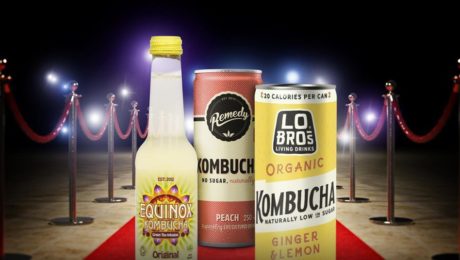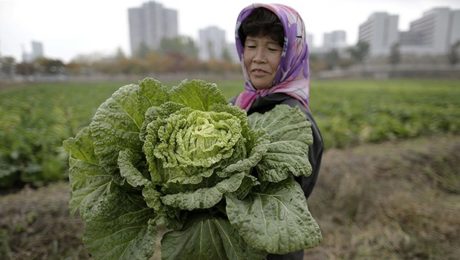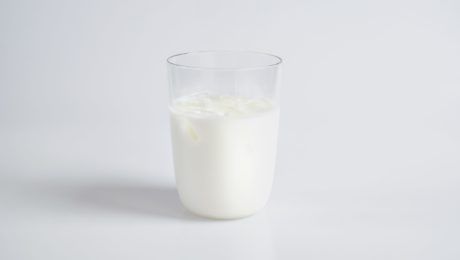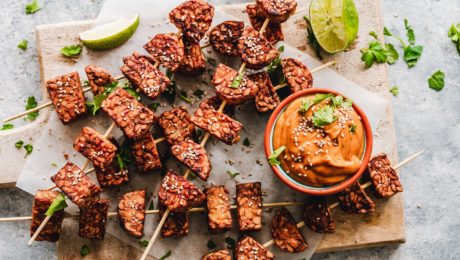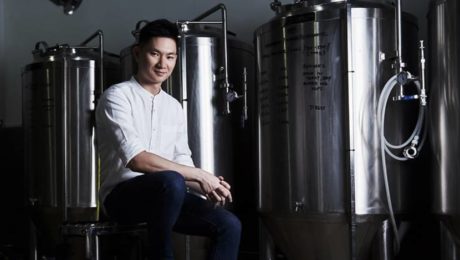Craft Kombucha Battles Big Brands
A group of craft kombucha brewers are banding together to fight industrialized kombucha. These small, UK-based companies say a number of big players are entering the kombucha space but taking mass production shortcuts, like pasteurizing and adding sweeteners. Many of the bigger brands, they say, are “kombucha in name only” making lab-engineered fermented tea without the fermentation.
“They don’t have time to ferment, some of them just use an instant mix, which totally goes against the grain of what kombucha is,” says Gary Leigh, founder of Go Kombucha and who that is leading what they’re calling the Real Kombucha Revolution. “Some make the kombucha, pasteurise it, kill off all the natural bacteria and add their own in.”
This consortium of craft brewers says mass-produced kombucha is edging out smaller, authentic brands. Craft brewers are struggling to compete when bigger companies are selling cheaper “kombucha” with a longer shelf life. Many consumers don’t realize what they are buying. Leigh stresses they’re not anti big kombucha brands, they just want brewers to be transparent about their production methods – they need to note on their labels if they’re pasteurized and/or they use sweeteners.
Read more (The Grocer)
TAGS:
- Published in Business, Food & Flavor
Cabbage Shortage Forces Halt in Winter Kimchi
A cabbage shortage is forcing North Koreans to give up winter kimchi making for the second year in a row. They are unable to take part in gimjang, the Korean tradition of communally preparing kimchi each October for the winter season.
Flood damage and poor crop yields led to a poor cabbage (and radish) growing season. The cabbage that was harvested was mostly routed to military and government agencies, “leaving the people empty handed.” Cabbage prices have risen 25% from a year ago, “making a large batch of kimchi cost more than a government-provided monthly salary,” according to Radio Free Asia.
Read more (Radio Free Asia)
- Published in Business, Food & Flavor
Primeval Poop Profiles
Studies of ancient poop found “humans as long as 2,700 years ago in the Iron Age were already using sophisticated techniques in flavoring the fermented foods.” They especially loved pairing pale ale with blue cheese.
A paper published in Current Biology detailed how researchers used paleo fecal samples found in salt mines in Austria to analyze the food ancient people were consuming. Their stool dehydrated in the salt, creating an ideal, preserved sample.
Researchers from the Institute for Mummy Studies, the University of Trento and the Vienna Museum of Natural History also found industrialization transformed the Western diet. Humans used to have healthier, more biodiverse gut microbiomes “because they were eating unprocessed foods.”
Frank Maixner, one of the paper’s lead authors, believes combining archaeology and microbiology could “illuminate the greater puzzle of human history.”
Read more (Popular Science)
- Published in Food & Flavor, Science
Chhurpi — Cheese from Chauri
Have you heard of chhurpi, the world’s hardest cheese? Developed thousands of years ago in a remote Himalayan village, it’s made from milk from a chauri (a cross between a male yak and a female cow) and is a favorite snack in pockets of eastern India, Nepal and Bhutan.
The protein-rich, low-fat cheese gets softer the longer it’s chewed — and people will chew on small cubes for hours. Chhurpi has low moisture content, making it edible for up to 20 years. It’s used in curries and soups or chewed as a snack (especially by yak herders during their long travels).
Chhurpi is fermented for 6-12 months, then stored in animal skin. It’s healthy and nutrient-rich, as chauri graze on herbs and grass in the high alpine mountains.
“It is said hard chhurpi takes anything between minutes to hours to soften, after which it tastes like a dense milky solid with a smoky flavour as it dissolves slowly. The so-called world’s hardest cheese is admittedly not everyone’s cup of tea, and I never could bite into one so far, but Nepalis across the country adore it,” writes BBC writer Neelima Vallangi.
Read more (BBC)
- Published in Food & Flavor
Global Kimchi Boom
South Korea’s exports of kimchi are at a record high — they have increased nearly 14% year-over-year in 2021 through August.Exports were highest to Japan ($57.2 million), U.S. ($18.9 million) and Hong Kong ($5.4 million). South Korea is expected to have a trade surplus in kimchi for the first time in 12 years.
Korea Customs Service and food industry experts attribute the rise to a few factors. First, growing consumer desire for healthier food. Second, kimchi is regularly highlighted by the media during the Covid-19 outbreak as a food that can boost immunity (note that this has not been scientifically proven). And third, “foreigners’ greater interest in Korean foods thanks to the popularity of Korean pop culture abroad.”
Read more (Korea Business Wire)
- Published in Business
Dairy Alternative from Fermented Pea & Rice
Researchers have discovered a milk alternative: fermenting pea and rice with probiotic strains. This dairy-free mixture is highly digestible and has the same animal protein as found in milk, casein.
Fermentation was critical to the results. Plant-based proteins are poorly digested because they are often insoluble in water, explains Professor Monique Lacroix of Institut National de la Recherche Scientifique (INRS). Animal proteins, in contrast, “usually take the form of elongated fibers that are easily processed by digestive enzymes.” But lactic acid bacteria in the fermented pea and rice drink predigested the proteins, improving digestibility.
“Fermentation allowed for the production of peptides (protein fragments) resulting from the breakdown of proteins during fermentation, facilitating their absorption during digestion,” notes an article on the research in Nutrition Insight.
INRS partnered with probiotics company Bio-K+ on the research. Their findings were published in the Journal of Food Science.
Read more (Nutrition Insight)
- Published in Science
Ireland’s Fermented Drinks Under Scrutiny
After a study found 91% of plant-based, fermented drinks in Ireland make unauthorized health claims, the Food Safety Authority of Ireland (FSAI) has published a guide on how to produce such beverages safely and label them accurately.
The FSAI examined 32 unpasteurized drinks currently sold on the Irish market – including kombucha, kefir and ginger soda – and found that most did not comply with EU and Irish food labelling and health regulations. The study found 13% had alcohol levels above labelling thresholds, and 75% lacked required label information, like the address of the producer and “best-before” date.
“The methods used in producing unpasteurized fermented plant-based products can be difficult to manage,” notes Dr. Pamela Byrne, FSAI chief executive. “The guidance will help producers to achieve consistent production methods, safe storage, safe handling and safe transportation of fermented beverages.”
Read more (Agriland)
Reviving Singapore’s Fermentation Culture
Singapore’s so-called “Prince of Fermentation” wants his country to develop “its own brand of fermentation culture.” Tan Ding Jie says Singapore’s traditional ferments are often left out of “the gospel of fermentation.”
“Cinchalok, fish sauce, fermented bean curd, fermented bamboo shoots – these are all very interesting ideas. People who are more mature have been quite ready to adapt koji from Japan and red yeast rice from Asia in their Western restaurants – so I think we should also be able to adapt or loan some of their ideas and use them in our cuisine.”
Tan Ding Jie, a researcher for Singapore’s Agency for Science, Technology and Research, is currently pursuing a master’s degree in food science. Jie consults for different Singapore restaurants and bars on how to use ferments in their menus. He created a fish sauce and nata de coco at the Michelin-starred Labyrinth restaurant, and created kombucha-infused cocktails for Gibson, one of Asia’s top bars. He started his own brand, Starter Culture, and teaches fermentation workshops and sells his own kombucha.
In an interview with Channel News Asia, Jie said he thinks there’s “much to be discovered from looking into our Southeast Asian culinary heritage. … I think Singapore is unique because we haven’t been afraid to say, ‘Let’s learn what are the best practices in the world today, and then apply it to our local context.’ If you look at Southeast Asian ferments, it’s also very simple – we took what immigrants brought over and said, ‘All right, that’s the history, let’s make it local.’”
Read more (Channel News Asia)
- Published in Food & Flavor
Wood Alternative from Kombucha Waste
A new wood alternative made from a byproduct of kombucha brewing waste won this year’s James Dyson Award, which celebrates problem-solving design. The material, called Pyrus, was invented by sustainable-design student Gabe Tavas. Tavas’ company, Symmetry, makes small items from Pyrus that replicate exotic woods like mahogany or purpleheart (two wood types found in the rainforest and endangered by aggressive deforestation).
Tavas was inspired to create Pyrus after seeing designers use kombucha bacterial cellulose (the film that grows on top of the beverage during brewing) in various projects. Tavas was struck by the fact that trees are made from cellulose, and he began experimenting in his dorm room with the waste from his own kombucha brewing. He eventually partnered with local Chicago producer, KombuchAde, which supplies Tavas with 250 pounds of cellulose a day.
Pyrus is made by pouring cellulose into a mold, adding agar (an algae-based binding gel), and then dehydrating and compressing it. The synthetic wood can be sanded and cut, but will decompose in contact with water.
Read more (Fast Company)

